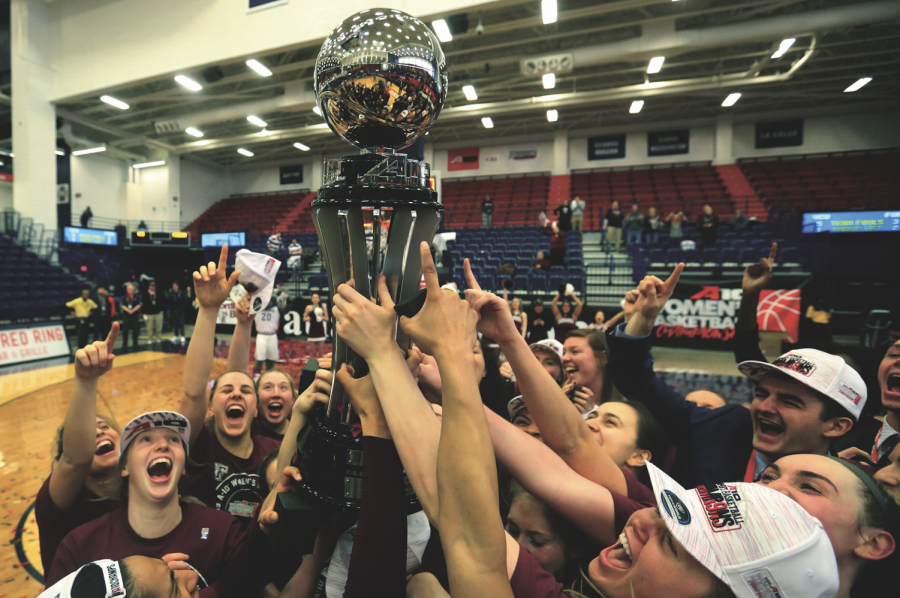Not a King’s Court
Fordham’s women’s basketball reached a pinnacle of their sport in a sea of empty bleachers and, even in defeat, deserve more from their community.
Following a 62-47 victory over Virginia Commonwealth, women’s basketball celebrates their Atlantic 10 Championship and automatic NCAA Tournament berth. Photo Courtesy of Austin Moriasy.
March 31, 2019
To anyone not paying attention, it must have come as a surprise to see Fordham women’s basketball roll through the Atlantic 10 and enter as a 14 seed in the NCAA Tournament last Saturday. In the Round of 64, they played the 3 seed, Syracuse University, a team that had thrived in much deeper waters than the Rams had tread in the Atlantic 10. In this difficult position against a superior team, Fordham did not go easily but was eventually defeated soundly by a 70–49 score, eliminating them from the national tournament.
To the average bystander, a 21-point defeat in the NCAA Tournament would be seen as a disappointment. There are programs that expect success from all of their sports, and a first-round exit would then be considered a failure.
To the chagrin of some Fordham Sports fans, however, this women’s basketball team has proved to be the most successful team on campus this year. In addition, national recognition is a rare feat for Fordham athletics, and women’s basketball achieved it despite falling short against a superior Syracuse team. Even as Fordham’s most decorated team, the spotlight on their success remains dimmed, and the crowds were always sparse compared to their male counterparts. They had to constantly work within the stereotype of women’s basketball as a joke.
Throughout the season, Fordham was nearly unstoppable in the Atlantic 10 conference. Before entering conference play, the Rams participated in invitationals with the top teams in the country, and at this level, the Rams’ competed in a way few expected of them. Against their conference rivals, they dominated, compiling a 13–3 record.
Earning the 2 seed in the Atlantic 10 Tournament, they completely dismantled their competition, defeating UMass, Duquesne and Virginia Commonwealth in short order to win the championship and a berth in the NCAA Tournament. In those three games, they won by a combined score of 211–143.
Though players like Lauren Holden, Fordham College at Rose Hill (FCRH) ’19, and Mary Goulding, FCRH ’19, proved to be great performers and leaders, Fordham’s success was largely driven by redshirt sophomore Bryson Cavanaugh, FCRH ’21. Cavanaugh led Fordham to many key victories and was especially dominant during their tournament run, averaging 23 points per game during that stretch.
This team was any basketball fan’s dream: a team with senior leadership bolstered by the spectacular play of an up-and-coming phenom. But for the majority of the season, Fordham women’s basketball saw very small attendance numbers.
A lack of attention on campus can be viewed as part of a larger dismissal of women’s athletics, and to a degree, that is a strong point of contention. During a conversation about March Madness, a Fordham alum, who has asked to remain anonymous, said that the Fordham basketball program needed work. When reminded of the women’s success, he responded, “Sure, but what are we focusing on really?”
While this is undoubtedly a problem plaguing women’s basketball in general, it does not affect Fordham more than it does any other university. In fact, Fordham women’s basketball received widespread national attention last week, when they were invited on to the Tonight Show with Jimmy Fallon to throw cheese at the host in anticipation of their matchup against Syracuse.
Putting aside the current quality of NBC programming, this basketball team has reached a platform very few people ever do, and yet they played most of their home games to empty stands. In essence, Fordham students were presented a winning product representative of their school and its values two to three nights a week this winter, and they declined the opportunity to attend.
While the games of a 25–9 basketball team were largely shunned by students, the 12–20 men’s basketball team regularly enjoyed more considerable crowds, even when diminished by the team’s lackluster record.
Cavanaugh said that her team “could play a team that’s number one in the conference and only a handful of students show up,” while “the men’s team could be 0–12 and both sides of the gym are filled with students and faculty.”
In men’s sports, competency is often rewarded, and conversely, poor performances are responded to with poor attendance. Fordham football had dismal attendance numbers after a very turbulent season, and the home court advantage was seldom utilized fully by men’s basketball as they struggled against their conference rivals.
On the other hand, the women’s basketball team was not only competent, but excelled over their competition. In the most strenuous situations, Fordham dominated their local rivals to a degree that earned them national recognition.
Any sports fan at Fordham should want to be a part of that success, and if school spirit were truly at the heart of every fan’s enthusiasm, Fordham women’s basketball would be sold out every night. Instead, their accomplishments are diminished to those of a second-tier sport.
If a person in general society were to choose between attending an NBA and WNBA game, it would be acceptable for that person to choose the NBA game if that is the product they prefer. However, Fordham students should not choose to attend games in the same way. In their case, the connection to a university is far more personal than that of a state or city.
School spirit should be the driving force behind the decision to attend a Fordham sporting event, and that spirit should be rewarded by teams who perform at a level representative of their school’s standards and expectations.
In Cavanaugh’s words, “we do feel like we deserve more attention but it doesn’t affect how we play because we play for each other. We don’t play to please the fans and spectators.” Despite playing most of the season to an empty student section, women’s basketball performed at an exceptional level and deserve recognition for accomplishing things that no other athletic team at Fordham has come close to achieving in the 2018-19 academic school year.













